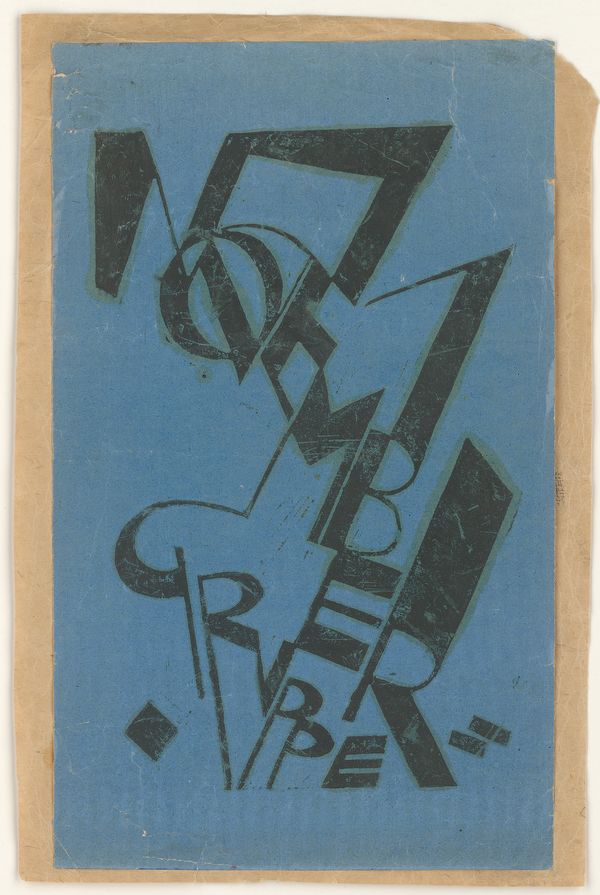The "Novembergruppe" was formed in late 1918 as a reaction to the November Revolution. Its members included artists, architects, writers and composers of various stylistic tendencies such as Rudolf Belling, Hanns Eisler, César Klein, El Lissitzky, Ludwig Mies van der Rohe, Otto Möller, Max Pechstein, Artur Segal and Bruno Taut. Until it was banned in 1933, the group generally comprised circa 120 members, who shaped the art world in Berlin. It demanded an influence on art politics, e.g. collaboration on public building projects and involvement in the development of art legislation and the allocation of exhibition space. The association took part with an own section from 1919 till 1937 in the “Great Berlin Art Exhibition” and organized numerous events overlapping into fields beyond fine art, such as concerts of contemporary music or film screenings. Moriz Melzer suggested “The Triad” (Der Dreiklang) as a programmatic title for a magazine issued by the “Novembergruppe” and designed a title page which has survived.
Eberhard Roters, the founding director of the Berlinische Galerie, was ahead of his time in recognizing the role played by the Novembergruppe in establishing what is now regarded as Classical Modernism and also in boosting the cultural credentials of this city. The collection already included works by members of the association, including Rudolf Belling, Ernst Fritsch, Raoul Hausmann, Hannah Höch, Walter Kampmann, Issai Kulvianski, Moritz Melzer, Heinrich Richter-Berlin and Arthur Segal. Moreover, the Architecture Collection at the Berlinische Galerie held material on work by Novembergruppe activists Hugo Häring, Wassili and Hans Luckhardt, Hans Scharoun and Bruno and Max Taut.
When the museum acquired the literary estate of Hannah Höch in 1979, a unique corpus in both its size and its quality, it was enriched by a trove of documents shedding light on the association’s activities and internal disputes. The literary estate of Raoul Hausmann acquired in 1991, and the literary estate Otto Möller, obtained by the Artists’ Archives at the Berlinische Galerie in 1999 in the form of a generous gift, likewise harbour important documents by and on the Novembergruppe. The history of reception surrounding the association is also ripe for the archives, as testified by the records and manuscripts underlying the first monographic account of the Novembergruppe in 1969, kindly handed over the museum in 1999 by its researcher and author Helga Kliemann.
This collection essentially called upon scholars to revisit the Novembergruppe, sparking a research project lasting several years with funding from the Gerda Henkel Stiftung. The output from that project provided the groundwork for the genesis of the exhibition “Freedom. The Art of the Novembergruppe (9th of November 2018 – 11th of March 2019 at the Berlinischen Galerie).

Moriz Melzer, Novembergruppe (typografischer Entwurf), um 1922
© Rechtsnachfolger Moriz MelzerPrinted in black on a blue ground is the title of the work “November Gruppe”. The word “November” stretches from top left to bottom right, and the word for “Group” is set apart underneath. The letters are composed of thin and thick lines and curves and edged in green. Some have been elongated, some are very narrow or distorted, and in some places they run into each other.
Participation in Exhibition of the Novembergruppe 1919 – 1932
As far as can be deduced from printed catalogues, more than 480 artists exhibited with the Novembergruppe between 1919 and 1932. Taking part in an exhibition was not the same thing, however, as belonging to the association. From the outset, it was the Novembergruppe’s explicit policy to include numerous guests in its shows. Official membership was not required in order to participate, as exhibitions were invitation-based.
In the 1990s Armin Schulz, a former researcher at the Berlinische Galerie, compiled an initial systematic list of Novembergruppe members associated with the museum’s collection for in-house purposes. It was the basis for the present, much expanded compilation, which can be downloaded under the following link as PDF-File (in German Language).